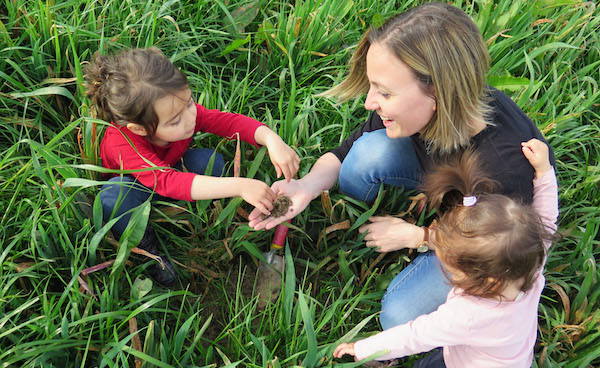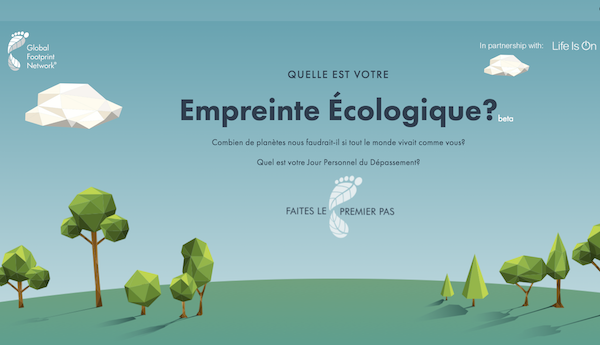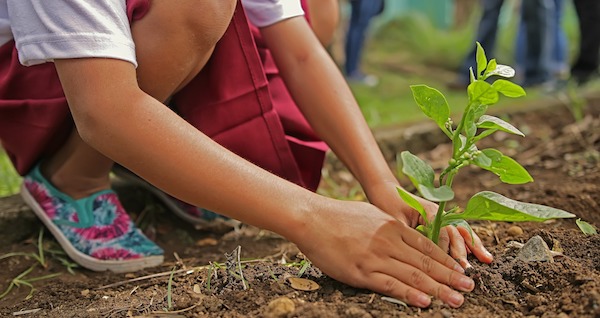Published on
“Would you like to carbon-offset your flight?”; “This event is carbon-neutral.”; “They offered me a carbon offset as a gift!”. In all likelihood you’ve heard or read about carbon offsetting these past few years.
For the April Action of the Month, we’d like to give you a brief overview of the concept, clarify certain aspects and fill you in on some of the subtleties. Above all, though, we’d like to suggest various ways of offsetting – but especially reducing! – your carbon footprint, be it in the workplace, at home or in your day-to-day life.
So we’re offering you an Équiterre cookbook of sorts, chock-full of carbon diet recipes that won’t have you counting GHG calories! (after all, we can’t cut out everything, otherwise we won’t stick to the diet). It’s better to choose impactful actions that you can phase in over your lifetime. That way it will be sustainable, and fun too!
SO, WHAT IS CARBON OFFSETTING ANYWAY?
Carbon offsetting is based on the principle that a given amount of GHG emitted in one area can be “offset” by a reduction or capture of an equivalent quantity of GHG emissions elsewhere in the world. Purchasers pay an organization to reduce in their name the GHG emissions for which they are responsible by investing in offset projects (carbon offset credits). (Référence)
Note: this article deals with voluntary offsets by individuals and organizations, rather than the carbon market regulating companies and governments.
Tree planting or reforestation programs are very popular carbon offset projects (trees absorb and store CO2) but, as you will see, there are numerous alternatives.
 *
*
*Did you know that trees aren’t the only things that store CO2? Our 2017-2018 Laure Waridel Bursary recipient Marie-Élise Samson is researching agricultural practices that can make it possible to store carbon in soil. Learn all about her project by visiting her page on Équiterre’s website.*
2. WHICH ACTIVITIES CAN BE OFFSET?
In theory, as long as the GHG emissions from an activity can be calculated (see item 5), then they can be offset.
Here are the most frequently offset activities:
Flights (either for business or pleasure) or automobile travel
Various events (conferences, sports or arts events, weddings)
Heating or electricity consumption
Purchase, use, consumption recycling and landfilling of goods and materials (clothing, furniture, etc.)

3. WHY SHOULD WE BE INTERESTED IN CARBON OFFSETTING AND WHAT ARE ITS LIMITATIONS?
Carbon offsets: a tool of last resort as part of an overall strategy
Carbon offsetting is but one component of a far broader GHG reduction strategy in the fight against climate warming. It should be the final alternative after trying to reduce GHGs at their source. It’s like they say: an ounce of prevention is worth a pound of cure!
After doing our best to change our habits, it is always possible to offset the remaining pollution (a 100% carbon-neutral lifestyle is impossible!). For example, car sharing services like Communauto offer users the chance to offset their trips in the company’s fleet of hybrid cars. Already, using a car sharing service is a significant step to reduce GHG emissions, since transportation accounts for nearly half of our environmental footprint!
Getting lost in the figures and losing our way
GHG calculations are not easy. There is a risk of getting lost in the figures and losing sight of the underlying purpose. It would be unfortunate if we poo-poohed or abandoned an activity that makes sense for us, our family or our business because it’s not as effective at reducing GHG emissions as some other activity. There is a good chance that initiatives that inspire us will have a lasting effect, influence those around us and encourage sustainable change.
For example, a business might decide to subsidize the purchase of bicycles/install showers/encourage public transit/promote carpooling by its employees rather than carbon offsetting their transportation. Promoting new habits when it comes to active or public transportation could snowball and lead to other lasting changes by employees and those around them.
A planet that lives on credit
We can’t simply offset ad infinitum on a planet with finite resources. Earth Overshoot Day arrives earlier and earlier each year – in other words, humanity’s demand for resources (ecological footprint) exceeds what Earth can regenerate in a given year (biocapacity), and the date by which we overshoot this biocapacity is now August 1 (in Canada it’s even earlier: March 18 – that’s barely three months!)
4. HOW TO CALCULATE OUR CARBON FOOTPRINT
For the average person, calculating GHG emissions is enough to make one’s head spin. Thankfully, there is no shortage of calculators on the web that can be used to illustrate and compare the impact of one activity versus that of another.
A number of offset organizations offer their own CO2 online calculator to help determine how to offset activities. This allows certain events to call themselves “carbon neutral.” That being said, the various offset organizations do not necessarily use the same calculating tool, so results may vary.
Let’s take the example of a direct round-trip flight from Montreal (YUL) to Paris (CDG) for one person (5 502 km):
Approximately 2 tonnes of CO2 emitted, requiring more than a dozen trees to be planted for a total of between $50 and $90 (the average of the following figures)
According to Planetair: $50.66 to offset 1.89 tonnes of CO2
According to Ecotierra: $50 to offset 2 tonnes of CO2
According to Scol'ERE: $37.53 to offset 1.45 tonnes of CO2
According to Carbon Boréal: 23 trees to plant ($91) to offset 3.27 tonnes of CO2
According to Compensation CO2 québec: 8 trees to plant ($33) to offset 1.33 tonnes of CO2
According to Atmosfaire: 60 Euros ($91) to offset 2.73 tonnes of CO2

*Perhaps you’ve heard of the Global Footprint Network, which offers a test to discover your ecological footprint. You’ll discover how many planets would be needed if everyone had your lifestyle! Note: here again, this test is designed merely to give you a general idea.*
5. CHOOSING THE BEST OFFSET ORGANIZATION/METHOD FOR YOU
Is the organization reliable and certified? There are several certifications and you must be on the lookout for fraud. Some organizations sell carbon credits for trees that have already been planted or would have been planted anyway, offset request or no (principle of additionality). You can also be duped into financing projects with little if any beneficial impact on the environment. So it’s really important to be well informed before choosing.
Which projects will be funded and where? Carbon offsetting is not just about planting trees – see item 6 to learn about some very worthwhile initiatives. Do you want to encourage local initiatives in Quebec, Canada or the developing world?
Is the project meaningful? You may opt to donate to an environmental organization without a carbon offset program but that is seeking to preserve biodiversity, protect our lands and forests or even educate people about the issues. The choice is yours! Of course, you can use one of the GHG calculating tools available online to figure out how much to donate to the organization of your choice, but when all is said and done, you should donate an amount that you can afford, for a cause that you find meaningful. Contact the organizations and ask what your donation will go toward. This will give you a clearer idea of what your donation will accomplish.
*The most common recognized certifications are the Clean Development Mechanism (CDM), the Gold Standard, The Voluntary carbon Standard, Climate, Community and Biodiversity Standards (CCB) and EcoLogo.*

MINI-DIRECTORY OF OFFSET ORGANIZATIONS
In 2009 the Pembina Institute and the David Suzuki Foundation produced a guide that includes a table comparing various offset organizations: « Purchasing Carbon Offsets: A Guide for Canadian Consumers, Businesses, and Organizations ».
Here are some Quebec organizations worth checking out:
- Arbre Évolution: Solidarity cooperative located in the Lower St. Lawrence prioritizing tree planting, ecosystem restoration, edible landscaping, carbon technologies and knowledge distribution. Promotes community involvement and youth awareness of the environment. Driving force behind Programme de reboisement social. Consult their calculating tool for your activities.
- Carbone Boréal/UQAC : Tree planting for university research on such topics as the role of our forests in the fight against climate change. Affiliated with the Université du Québec à Chicoutimi.
- Scol’ERE : The purchase of Crédits carbone éducatifsMD funds a 10-hour school program for 9-to-12-year-olds in Quebec. This fun program helps them discover and devise methods of reducing their family’s GHG emissions.
-Planetair : In conjunction with its international partners, offers only Gold Standard carbon credits from projects involving renewable energy, energy efficiency, waste management, reforestation, improvements in farm production and access to drinking water around the planet, not to mention urban and semi-urban reforestation projects in Quebec.
- Compensation CO2 Québec : Offsetting via tree reforestation and new forests in southern Quebec by assigning a plot of land located in an identified carbon sink.
- Ecotierra : Developing sustainable forestry and agroforestry projects. With offices in Canada, Peru, Colombia and Côte d’Ivoire.

To plan a Quebec trip to reduce its vacation GHG emissions? Have you considered beautiful Gaspésie?
ALTERNATIVES SUGGESTED BY ÉQUITERRE
To be proactive in reducing GHG emissions (transformation of behaviours) rather than simply reacting (offsetting), we suggest the following ideas on how to reduce your GHG emissions:
PSTT, be green and woke! Tell your employer about these initiatives!
To make your event carbon-neutral and ecologically responsible:
- Opt for an organic/local caterer
- Use reusable dishes
- Don’t hand out promotional items
- Promote active and public transportation to get to your event
Initiatives for the workplace
Encourage telework or teleconferencing (rather than meetings and air travel). Technology is making our lives easier!
Use reusable mugs or glasses when you get liquid refreshment
Offer employees locally sourced organic meals
Offer fair-trade coffee, tea or hot chocolate
Offer employees incentives to using active transportation, public transit or ride-sharing. Encourage train or bus travel rather than renting a car, but if it’s necessary to rent a car, make it an electric one
Alternate vacation trips abroad with local travel.
Surely there are some local spots that you’ve been itching to discover!
Ski vacations or all-inclusives in Quebec!
Parcs Québec and Parks Canada; discover the Maritimes, the Îles de la Madeleine, the Gaspésie and the eastern US
Parks in Nunavik and Nunavut
Food
Eat organic and local, and encourage Quebec’s family farmers by subscribing to the Family Farmers Network
Reduce your meat consumption
Consumption
Consult the Équiterre Action of the month section for ideas
Tips and resources on how to repair instead of throw away
Get involved in a cause or an organization
Can’t afford to donate? Volunteer your time for an environmental cause!
No time? There are other ways to get involved: bone up on the issues, vote, sign a petition! Read and share an article or publication, share a green solution by email or via social media. Get your friends and family thinking and acting green!
Learning about carbon offsets, whether you decide to go that route or not, can act like a sparkplug. It can lead to other sustainable actions aimed at making the planet greener and its inhabitants happier.

Eat organic and local, and encourage Quebec’s family farmers by subscribing to the Family Farmers Network
TO LEARN MORE
« S’acheter une bonne conscience avec la compensation carbone : Explications de Steven Guilbeault » à Gravel le matin
« Une compensation carbone comme cadeau de Noël, ça vous dit? » au 15-18, Radio-Canada Première
Article Ici Explora « Martine magasine les crédits de compensation carbone »